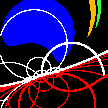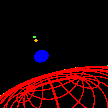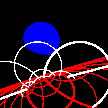|
index
|
|
Movie
 Falling to the singularity of the black hole (217K GIF
Falling to the singularity of the black hole (217K GIF
|
The photon sphere
 \(1.5\) Schwarzschild radii from the singularity.
This is the location of the innermost unstable circular orbit.
To maintain circular orbit at this radius requires going at the speed of light.
In particular light itself can orbit the black hole
in circular orbits at this radius.
For this reason,
this location is sometimes called the photon sphere.
Inside \(1.5\) Schwarzschild radii,
no circular orbits exist, stable or unstable:
all free fall orbits fall into the black hole.
To maintain orbit inside \(1.5\) Schwarzschild radii without falling in,
it would be necessary to keep rockets constantly on burn.
Answer to the
quiz question 1:
False.
Photons do not orbit in circles at the horizon,
just skimming the surface.
The place where photons orbit in circles is the photon sphere,
at \(1.5\) Schwarzschild radii.
Photons emitted at the horizon fall in;
except that if a photon is emitted exactly vertically outward
exactly at the horizon,
then it will hover at the horizon, not moving at all.
\(1.5\) Schwarzschild radii from the singularity.
This is the location of the innermost unstable circular orbit.
To maintain circular orbit at this radius requires going at the speed of light.
In particular light itself can orbit the black hole
in circular orbits at this radius.
For this reason,
this location is sometimes called the photon sphere.
Inside \(1.5\) Schwarzschild radii,
no circular orbits exist, stable or unstable:
all free fall orbits fall into the black hole.
To maintain orbit inside \(1.5\) Schwarzschild radii without falling in,
it would be necessary to keep rockets constantly on burn.
Answer to the
quiz question 1:
False.
Photons do not orbit in circles at the horizon,
just skimming the surface.
The place where photons orbit in circles is the photon sphere,
at \(1.5\) Schwarzschild radii.
Photons emitted at the horizon fall in;
except that if a photon is emitted exactly vertically outward
exactly at the horizon,
then it will hover at the horizon, not moving at all.
|
At the horizon, the Schwarzschild surface
 At exactly \(1\) Schwarzschild radius,
the horizon, the Schwarzschild surface.
The point of no return.
An observer outside the black hole cannot see us beyond this point -
we would appear to take an infinite amount of time to pass through,
becoming slower and more redshifted as time goes by.
But from our own point of view space and time continue normally.
The small white dot indicates our point of entry through the horizon.
Remarkably,
the Schwarzschild surface, the red grid, still appears to
stand off at some distance ahead of us.
The white dot is actually a line which extends from us to the Schwarzschild
surface still ahead, though we only ever see it as a dot, not as a line.
The dot-line marks the formation of the Schwarzschild bubble
(see below), and our entry into that bubble.
Persons who fell through the Schwarzschild surface at this precise point
before us would lie arrayed along this dot-line.
At this instant, as we pass through the horizon into the Schwarzschild bubble,
we see all the other persons who passed through this location before us
also pass through the horizon into the bubble.
The tidal force between head and toes is now \(1\) million gees,
for this \(30\) solar mass black hole.
But the tides wouldn’t be so bad for a very massive black hole.
The tide at \(1\) Schwarzschild radius would be less than \(1\) gee
if the black hole exceeded \(30{,}000\) solar masses.
From here to the central singularity will take \(0.0001\) seconds in free fall,
for this \(30\) solar mass black hole.
The infall time is proportional to the mass of the black hole.
Relative to an observer stationary in the Schwarzschild metric,
our velocity has now reached the speed of light.
Relative to an observer freely falling radially from rest at infinity,
our velocity is
\(\sqrt{8/9} \, c = 0.94 \, c\).
Answer to the
quiz question 2:
No, the horizon is not the place where you are suddenly torn apart.
In a stellar-sized black hole like this one,
the tidal force would already have torn you apart well outside the horizon.
In a supermassive black hole the tidal forces are weaker,
and you could survive well inside the horizon of the black hole
before being torn apart.
Answer to the
quiz question 3:
To remain at rest just above the horizon,
you would have to accelerate like crazy just to stay put.
Radial distances measured in your frame are greatly
stretched compared to radial distances measured by observers who
go with the flow,
so you’d have to pay out your fishing line a long way before it
hit the horizon.
The acceleration goes to infinity for something that attempts to
remain at rest at the horizon,
so the fishing line that passed the horizon would either break,
or drag you in.
At exactly \(1\) Schwarzschild radius,
the horizon, the Schwarzschild surface.
The point of no return.
An observer outside the black hole cannot see us beyond this point -
we would appear to take an infinite amount of time to pass through,
becoming slower and more redshifted as time goes by.
But from our own point of view space and time continue normally.
The small white dot indicates our point of entry through the horizon.
Remarkably,
the Schwarzschild surface, the red grid, still appears to
stand off at some distance ahead of us.
The white dot is actually a line which extends from us to the Schwarzschild
surface still ahead, though we only ever see it as a dot, not as a line.
The dot-line marks the formation of the Schwarzschild bubble
(see below), and our entry into that bubble.
Persons who fell through the Schwarzschild surface at this precise point
before us would lie arrayed along this dot-line.
At this instant, as we pass through the horizon into the Schwarzschild bubble,
we see all the other persons who passed through this location before us
also pass through the horizon into the bubble.
The tidal force between head and toes is now \(1\) million gees,
for this \(30\) solar mass black hole.
But the tides wouldn’t be so bad for a very massive black hole.
The tide at \(1\) Schwarzschild radius would be less than \(1\) gee
if the black hole exceeded \(30{,}000\) solar masses.
From here to the central singularity will take \(0.0001\) seconds in free fall,
for this \(30\) solar mass black hole.
The infall time is proportional to the mass of the black hole.
Relative to an observer stationary in the Schwarzschild metric,
our velocity has now reached the speed of light.
Relative to an observer freely falling radially from rest at infinity,
our velocity is
\(\sqrt{8/9} \, c = 0.94 \, c\).
Answer to the
quiz question 2:
No, the horizon is not the place where you are suddenly torn apart.
In a stellar-sized black hole like this one,
the tidal force would already have torn you apart well outside the horizon.
In a supermassive black hole the tidal forces are weaker,
and you could survive well inside the horizon of the black hole
before being torn apart.
Answer to the
quiz question 3:
To remain at rest just above the horizon,
you would have to accelerate like crazy just to stay put.
Radial distances measured in your frame are greatly
stretched compared to radial distances measured by observers who
go with the flow,
so you’d have to pay out your fishing line a long way before it
hit the horizon.
The acceleration goes to infinity for something that attempts to
remain at rest at the horizon,
so the fishing line that passed the horizon would either break,
or drag you in.
|
The Schwarzschild bubble grows
 At \(0.68\) Schwarzschild radii.
The split region of the Schwarzschild surface grows.
If we see someone enter the Schwarzschild bubble through the upper (white)
surface,
then the moment of passage marks the instant when we see them
pass inside the horizon of the black hole.
Answer to the
quiz question 5:
False.
You do NOT see all the future history of the world played out.
Once inside the horizon,
you are doomed to hit the singularity in a finite time,
and you witness only a finite (in practice rather short) time pass
in the outside Universe.
In order to watch the history of the Universe unfold,
you would have to remain outside the horizon, the Schwarzschild surface.
One way to watch all the history of the Universe
would be to stay just above the horizon,
firing your rockets like crazy just to stay put.
The Universe would then appear not only speeded up,
but also highly blueshifted (probably roasting you in gamma rays),
and concentrated in a tiny piece of the sky just above you.
Personally if I had all that rocket power available,
I wouldn’t use it to hover just above the horizon of a black hole.
I’d rather take a trip around the Universe.
Thanks to special relativistic time dilation,
I could travel vast distances in a modest time,
at superluminal speeds — apparently faster than the speed of light.
Answer to the
quiz question 6:
False.
You do NOT see the outside Universe concentrate into an ever diminishing
patch of the sky above you,
which finally disappears altogether as you pass into the horizon.
This misleading notion appeared in
Black Holes: The Ultimate Abyss,
which was otherwise a wonderful show with beautiful graphics,
broadcast on the
Discovery Channel on 12 Oct 1997.
What is true is that the outside Universe would concentrate into a small
region above you if you hovered just above the horizon,
firing your rockets like crazy to stay put.
But fire your rockets how you will,
the view of the outside Universe will not disappear
once you are inside the horizon.
At \(0.68\) Schwarzschild radii.
The split region of the Schwarzschild surface grows.
If we see someone enter the Schwarzschild bubble through the upper (white)
surface,
then the moment of passage marks the instant when we see them
pass inside the horizon of the black hole.
Answer to the
quiz question 5:
False.
You do NOT see all the future history of the world played out.
Once inside the horizon,
you are doomed to hit the singularity in a finite time,
and you witness only a finite (in practice rather short) time pass
in the outside Universe.
In order to watch the history of the Universe unfold,
you would have to remain outside the horizon, the Schwarzschild surface.
One way to watch all the history of the Universe
would be to stay just above the horizon,
firing your rockets like crazy just to stay put.
The Universe would then appear not only speeded up,
but also highly blueshifted (probably roasting you in gamma rays),
and concentrated in a tiny piece of the sky just above you.
Personally if I had all that rocket power available,
I wouldn’t use it to hover just above the horizon of a black hole.
I’d rather take a trip around the Universe.
Thanks to special relativistic time dilation,
I could travel vast distances in a modest time,
at superluminal speeds — apparently faster than the speed of light.
Answer to the
quiz question 6:
False.
You do NOT see the outside Universe concentrate into an ever diminishing
patch of the sky above you,
which finally disappears altogether as you pass into the horizon.
This misleading notion appeared in
Black Holes: The Ultimate Abyss,
which was otherwise a wonderful show with beautiful graphics,
broadcast on the
Discovery Channel on 12 Oct 1997.
What is true is that the outside Universe would concentrate into a small
region above you if you hovered just above the horizon,
firing your rockets like crazy to stay put.
But fire your rockets how you will,
the view of the outside Universe will not disappear
once you are inside the horizon.
|
Image distortion inside the black hole
 At \(0.35\) Schwarzschild radii.
Compare this view to the
unconventional view you would see if the Schwarzschild surface
were attached to another Universe via a wormhole.
Images are being distorted by two effects:
a tidal distortion from the gravity of the black hole,
and a special relativistic beaming from our near light speed motion.
Just as the tidal distortion redshifts images from above and below,
and blueshifts them about your middle,
so also it tends to repel images from above and below,
and concentrate them about your middle.
At first, images appear distorted into a kidney shape.
As the distortion grows,
images become stretched and squashed into a doughnut shape about your waist.
Our near light speed motion concentrates our view ahead,
by special relativistic beaming.
Relative to observers freely falling radially from rest at infinity,
our velocity increases towards the speed of light:
the relativistic Lorentz gamma factor at radius \(r\) is
\(1 + 2 r_s/r\).
At \(0.35\) Schwarzschild radii.
Compare this view to the
unconventional view you would see if the Schwarzschild surface
were attached to another Universe via a wormhole.
Images are being distorted by two effects:
a tidal distortion from the gravity of the black hole,
and a special relativistic beaming from our near light speed motion.
Just as the tidal distortion redshifts images from above and below,
and blueshifts them about your middle,
so also it tends to repel images from above and below,
and concentrate them about your middle.
At first, images appear distorted into a kidney shape.
As the distortion grows,
images become stretched and squashed into a doughnut shape about your waist.
Our near light speed motion concentrates our view ahead,
by special relativistic beaming.
Relative to observers freely falling radially from rest at infinity,
our velocity increases towards the speed of light:
the relativistic Lorentz gamma factor at radius \(r\) is
\(1 + 2 r_s/r\).
|
|
The singularity
What happens to space and time now? Do space and time end? No one knows. Presumably the answer has something to do with a hitherto unfathomed theory of quantum gravity... maybe superstring theory? |
|
index
|
|